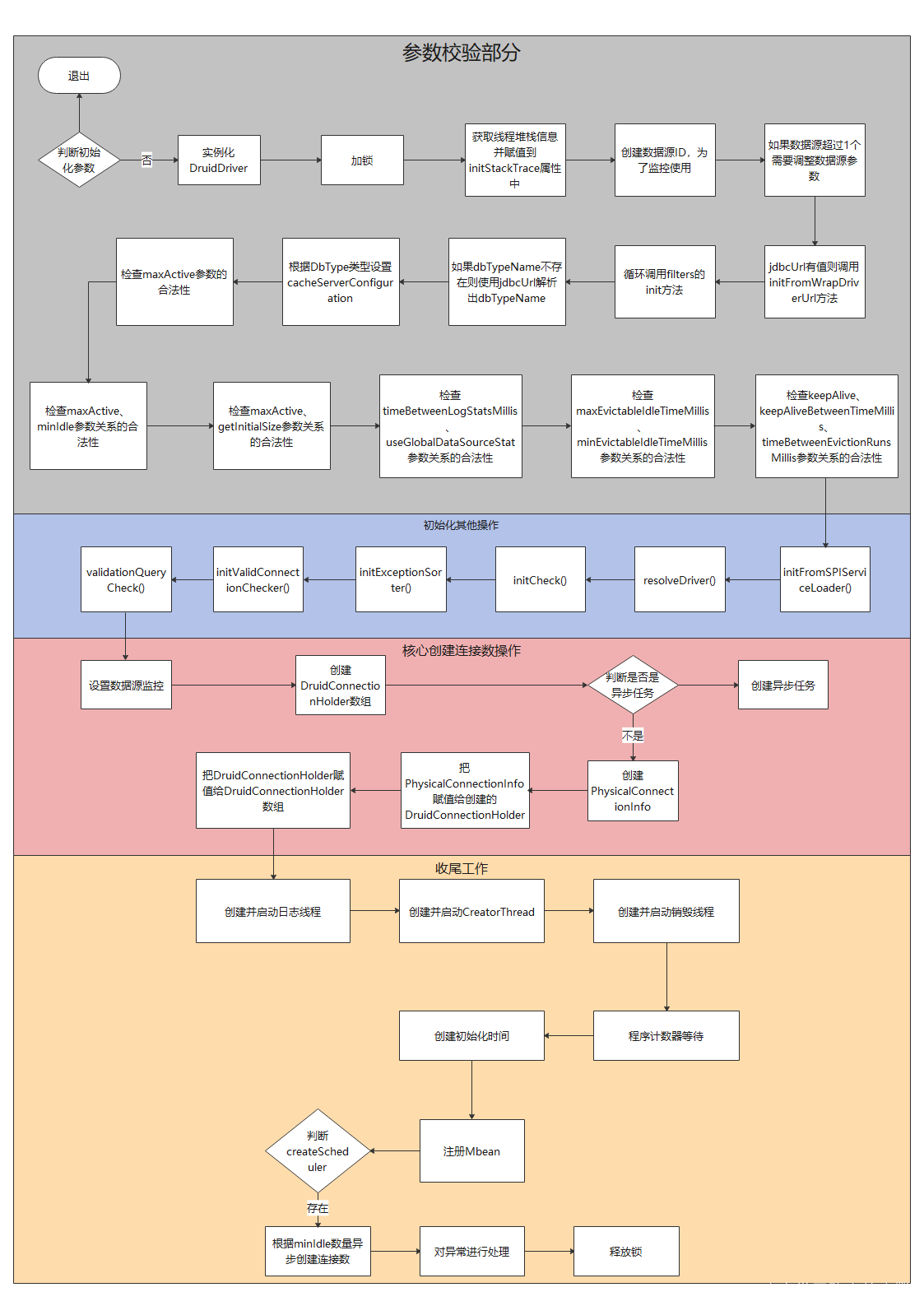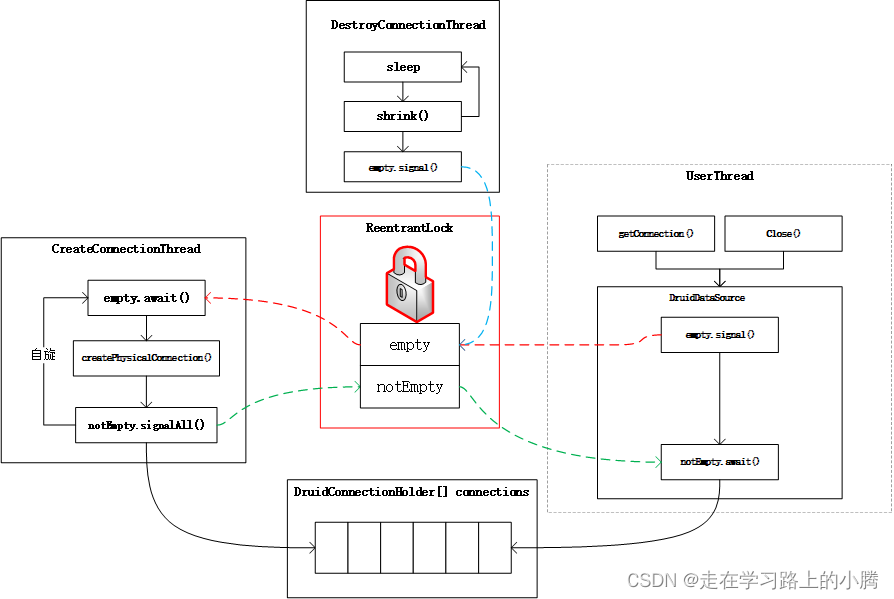总图

JDBC获取连接
DriverManager.getConnection(url, username, password);
//getConnection 方法
private static Connection getConnection(
String url, java.util.Properties info, Class<?> caller) throws SQLException {
/*
* When callerCl is null, we should check the application's
* (which is invoking this class indirectly)
* classloader, so that the JDBC driver class outside rt.jar
* can be loaded from here.
*/
ClassLoader callerCL = caller != null ? caller.getClassLoader() : null;
synchronized(DriverManager.class) {
// synchronize loading of the correct classloader.
if (callerCL == null) {
callerCL = Thread.currentThread().getContextClassLoader();
}
}
if(url == null) {
throw new SQLException("The url cannot be null", "08001");
}
println("DriverManager.getConnection(\"" + url + "\")");
// Walk through the loaded registeredDrivers attempting to make a connection.
// Remember the first exception that gets raised so we can reraise it.
SQLException reason = null;
for(DriverInfo aDriver : registeredDrivers) {
// If the caller does not have permission to load the driver then
// skip it.
if(isDriverAllowed(aDriver.driver, callerCL)) {
try {
println(" trying " + aDriver.driver.getClass().getName());
Connection con = aDriver.driver.connect(url, info);
if (con != null) {
// Success!
println("getConnection returning " + aDriver.driver.getClass().getName());
return (con);
}
} catch (SQLException ex) {
if (reason == null) {
reason = ex;
}
}
} else {
println(" skipping: " + aDriver.getClass().getName());
}
}
// if we got here nobody could connect.
if (reason != null) {
println("getConnection failed: " + reason);
throw reason;
}
println("getConnection: no suitable driver found for "+ url);
throw new SQLException("No suitable driver found for "+ url, "08001");
}逻辑大致就是获取所有的Driver,然后调用Driver的connect方法获取连接。mysql驱动的Driver代码如下:
public class Driver extends NonRegisteringDriver implements java.sql.Driver {
public Driver() throws SQLException {
}
static {
try {
DriverManager.registerDriver(new Driver());
} catch (SQLException var1) {
throw new RuntimeException("Can't register driver!");
}
}
}也就是说在MySQL中connect方法在父类中,查看父类NonRegisteringDriver的connect方法,方法代码如下:
public Connection connect(String url, Properties info) throws SQLException {
try {
try {
if (!ConnectionUrl.acceptsUrl(url)) {
return null;
} else {
ConnectionUrl conStr = ConnectionUrl.getConnectionUrlInstance(url, info);
switch(conStr.getType()) {
case SINGLE_CONNECTION:
return ConnectionImpl.getInstance(conStr.getMainHost());
case FAILOVER_CONNECTION:
case FAILOVER_DNS_SRV_CONNECTION:
return FailoverConnectionProxy.createProxyInstance(conStr);
case LOADBALANCE_CONNECTION:
case LOADBALANCE_DNS_SRV_CONNECTION:
return LoadBalancedConnectionProxy.createProxyInstance(conStr);
case REPLICATION_CONNECTION:
case REPLICATION_DNS_SRV_CONNECTION:
return ReplicationConnectionProxy.createProxyInstance(conStr);
default:
return null;
}
}
} catch (UnsupportedConnectionStringException var5) {
return null;
} catch (CJException var6) {
throw (UnableToConnectException)ExceptionFactory.createException(UnableToConnectException.class, Messages.getString("NonRegisteringDriver.17", new Object[]{var6.toString()}), var6);
}
} catch (CJException var7) {
throw SQLExceptionsMapping.translateException(var7);
}
}其逻辑就是根据url字符串判断创建什么样的连接。这里面包括了单连接、负载均衡模式下的连接代理、主从模式下的连接代理。至此连接就创建好了。
Druid中init方法创建连接
直接创建
init方法,如果是非异步init则会直接创建连接。代码如下:
while (poolingCount < initialSize) {
try {
PhysicalConnectionInfo pyConnectInfo = createPhysicalConnection();
DruidConnectionHolder holder = new DruidConnectionHolder(this, pyConnectInfo);
connections[poolingCount++] = holder;
} catch (SQLException ex) {
LOG.error("init datasource error, url: " + this.getUrl(), ex);
if (initExceptionThrow) {
connectError = ex;
break;
} else {
Thread.sleep(3000);
}
}
}
if (poolingCount > 0) {
poolingPeak = poolingCount;
poolingPeakTime = System.currentTimeMillis();
}关键方法就是createPhysicalConnection方法。根据名字可以判断是创建物理连接信息。关键代码如下:
public Connection createPhysicalConnection(String url, Properties info) throws SQLException {
Connection conn;
if (getProxyFilters().size() == 0) {
conn = getDriver().connect(url, info);
} else {
conn = new FilterChainImpl(this).connection_connect(info);
}
createCountUpdater.incrementAndGet(this);
return conn;
}是调用的驱动的connect方法。这里就和jdbc方式对应上了。
而PhysicalConnectionInfo类是Druid定义的,除了数据库连接意外还包括了其他一些辅助功能的参数对象。从上面init逻辑中也能看出,创建的PhysicalConnectionInfo对象被封装放到了holder对象中。同时把holder对象赋值给了数组。由此可以看出DruidConnectionHolder 对象是Durid中的一个关键对象。
异步创建
异步方法这里就要分析如下的代码:
createAndLogThread();
createAndStartCreatorThread();
createAndStartDestroyThread();这里使用到了线程,虽然核心逻辑还是创建连接、销毁连接。就是上面的逻辑。但是这里面使用了多线程的计数器、锁、以及条件控制来实现了DruidConnectionHolder数组的生产与消费。关键类如下:
protected ReentrantLock lock;
protected Condition notEmpty;
protected Condition empty;
private final CountDownLatch initedLatch = new CountDownLatch(2);
核心逻辑可以参考下图:

总结:
1.获取连接最终还是使用了数据驱动中类来创建物理连接,Druid把这个物理连接封装到了自己的对象中。
2.在使用多线程时,ReentrantLock 与 Condition 配合可以实现一个生产者/消费者模式。






















 768
768











 被折叠的 条评论
为什么被折叠?
被折叠的 条评论
为什么被折叠?








